For next installment of our Battle of Britain-saga we selected scenario with very suitable title 'Duel of Eagles'. It was our first pure fighter game, which was a nice change of pace from previous games, where bombers were the primary targets.
The setup
Historical encounter depicted by 'Duel of Eagles' was between elements of Jagtgeschwader 26 and Squadron No.76. Pilots of both formations were very experienced and both were led by an ace - Adolf Galland and "Sailor" Malan. To reflect this fact, both sides in our game had an Ace pilot and a bunch of Veteran pilots each. R.A.F was represented by three sections of Spitfires, while Germans had four sections of Me109:s. Entry point and initial altitude of each section was determined randomly, although random Scenario Special Rule roll allowed the German side to enter one section of Messerschmitts at highest altitude at the beginning of round 2.
Random setups have sometimes tendency to put a certain spin on a game and this was one of those occassions. Malan's section entered the table at very low altitude and it was obvious that his formation would not have much influence on the initial phase of the game. Galland's rote and second Spitfire section entered the table on the opposite sides of the table, at high altitude, but equally out of position. Third section of Spitfires was however definitely in trouble - two sections of 109:s were in their immediate vicinity. Furthermore, unbeknownst to the player controlling British fighters, last section of Messerschmitts would show up on their tails at the beginning of second round.
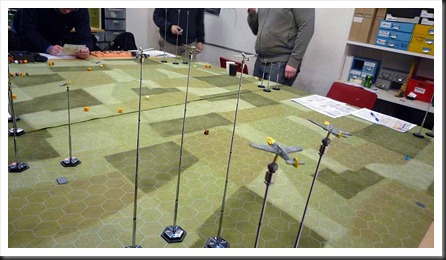 Separated Spitfire section at the start of the game
Separated Spitfire section at the start of the game
The game
It could be said that this game had two very distinct phases. First half was spent on maneuvers where every one of us was trying to select their targets and gain an advantageous position. On one side of the table focus lay on Malan's Spitfire section that started at very low altitude. This formation was a very obvious target for Galland's Messersmitts, which started to the right of Spitfires - both sections tuned into each other, Spitfires climbing, 109:s diving. Both sides opened fire simultaneously, missed and then they were past each other. While Malan's planes continued on same course, still climbing, Galland's rote met the other section of Spitfires that started on same side of the table. This time the Brits were the lucky ones - Galland's wingman was hit and damaged and both Messerschmitts were suddenly fighting for survival.
The picture was very different on the other side of the table. Single section of Spitfires, with enemy fighters both in front and behind them, had no choice but to run toward the middle of the table. Initially the only good news for those British planes was the fact that one of German flights was below them and had to climb before it posed a real threat, while the remaining 109:s didn't really have a good shooting resolution and choose not to open fire.
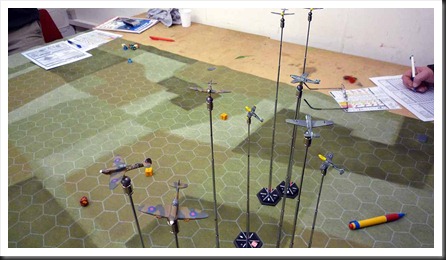 Between the rock and the hard place
Between the rock and the hard place
In other words, the game was at first separated in two separate chains of events. Then all airplanes found themselves in the middle of the table and at roughly same altitude. As it turns out, it was a recepy for total chaos - six Spitfires and eight Me109:s were basically on top of each other, every pilot having at least one target in its sights at any given time. For the first time we experienced a true dogfight.
Considering the amount of fire, surprisingly few hits were scored. First victim of the day was one of green Spitfires that turned the wrong way (incorrect plot) and found two Messerschmitts in its path. Short burst of cannon shells demolished the unfortunate Spitifre and it spun down to the ground. Another Spitfire was shot down shortly afterward by a random snapshot from a German fighter. The Brits returned the compliment and hit one of 109:s, setting its engine on fire.
 Engine on fire and long way away from France
Engine on fire and long way away from France
With two British fighters shot down, the Germans seemed to gain the upper hand. At this moment, Malan's flight finally found its way to the fight, with immediate and telling effect. A deflection shot from British ace found its target, putting the Messerschmitt into a spin from which it never recovered. Third Spitfire became victim of German fighters at the same time, but two of German fighters also run out of ammunition. Those events changed the picture dramatically - German planes found themselves outnumbered and in a disadvantageous position. Prefering prudence before glorious death for the Fatherland, all German pilots put the superiour diving speed of their planes to use and managed to exit the table without any additional loses.
Final score of the game - three Spitfires and one Messerschmitt shot down, two Messerschmitts damaged. Another German victory, but this one with much narrower margin than in previous games.
Musings after the game
This game made two things rather apparent. First, a game without bombers is a very different experience - there are no obvious targets and players can take their time, searching advantage of position or simply waiting for a mistake from the opponent. Second, a melee like the one that developed in this game is a very unhealthy proposition for everyone involved. Firing arcs are very generous in CY6 (and we are playing with the optional, narrow arc), so most of the time it is almost impossible to avoid potshots.
From practical point of view, I have to say that it wasn't the most enjoyable CY6 game I had opportunity to play. Chaos that developed made it rather hard to keep track of who was supposed to move when. Additionally, if one is to draw any conclusions from this game, dogfights tend to concentrate all the planes in a very narrow area. This fact creates some purely physical problems, as you can fit only so many bases in a single hex.
At the same time I have to say that 'Duel of Eagles' has a lot of replayability and does seem to be an excellent pick up scenario for multiple players. In our game we had three players on British side and four on the German. Two of them were complete beginners, but managed to be 'self-going' within a couple of rounds.
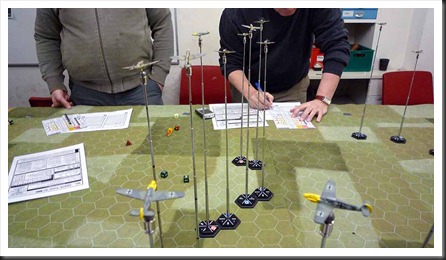
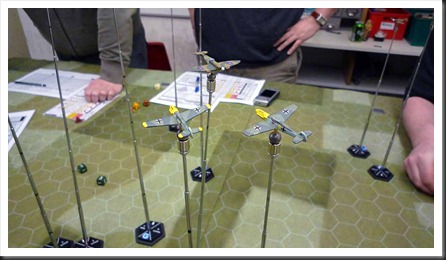
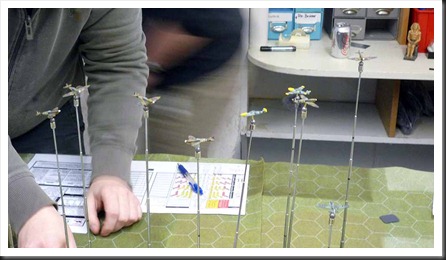
No comments:
Post a Comment